 Hardcover |
Kindle Edition |
Thrilling Incidents In American History |
Perry's Saints |
Prev |
Next
Hardcover |
Kindle Edition |
Thrilling Incidents In American History |
Perry's Saints |
Prev |
Next
The Jet MakersThe Aerospace Industry from 1945 to 1972• Title • Introduction • Preface • Acknowledgements • I: World War II: Aviation Comes of Age • II: The Aerospace Industry since World War II: A Brief History • III: The National Military Strategy: Background for the Government Markets • IV: The Principal Government Market: The United States Air Force • V: The Other Government Markets: The Aerospace Navy, the Air Army, and NASA • VI: Fashions in Government Procurement • VII: The Heartbreak Market: Airliners • VIII: Design or Die: The Supreme Technological Industry • IX: Production: The Payoff • X: Diversification: The Hedge for Survival • XI: Costs: Into the Stratosphere • XII: Finance and Management • XIII: Entry into the Aerospace Industry • XIV: Exit from the Aerospace Industry • XV: The Influence of the Jet Engine on the Industry • Notes • Acronyms • Annotated Bibliography |
IVTHE PRINCIPAL GOVERNMENT MARKET: THE UNITED STATES AIR FORCESince World War II the Air Force has been the largest customer for the aerospace industry. It has also been the principal instrument of American national military strategy, and its primary emphasis has been on grand-strategic attack.THE STRATEGIC AIR COMMANDIt has already been shown in Chapter I that the Army Air Forces emphasized long-range, four-engine strategic bombers, a policy which did much to make airplanes more generally useful and which brought them to their postwar size. The AAF emerged from World War II believing that the efficacy of its concepts of. grand-strategic bombing had been confirmed, and this belief provides the key to Air Force actions throughout the entire postwar period. Air Force leadership has always argued that grand-strategic attack is the most efficient means to conduct war, and that the heavy, or big, bomber was the best or at least necessary means to carry it out. All other functions and activities of airpower have, therefore, generally received only secondary attention. During the postwar years, the USAF continued development of its ideal aircraft, the bomber with global range, mainly on the strength of its strategic conceptions. When Russia emerged as the most likely enemy, the Air Force's predilections fit neatly into the one-war, air-nuclear military strategy.The chosen instrument at first was the giant B-36, with its six piston engines and four jet engines. Its design was set by the desire for a 10,000 mile range with 10,000 pounds of bombs, so that it could reach any significant global target and return to an American base. After some design difficulties were solved, the intercontinental B-36 exceeded expectations and was in practical use by 1949, thanks to the hybrid addition of more power through its jet engines. There were two means other than the intercontinental bomber for the Air Force to reach a target in the enemy's homeland. One was to use overseas bases for its aircraft, and some were regained when Western Europe became frightened about Russian intentions. The second way was to use aerial refueling. The Air Force had experimented with the idea between the wars, but the attempts were crude. After the war, the British developed the probe-and-drogue system, which used a flexible hose, and the Americans adopted it and used it for smaller aircraft. The Americans developed the flying-boom method, which transfers large quantities of fuel quickly, for large aircraft. Two schools of thought emerged in the Air Force on the fonn the aerial tanker would take. One believed in using a transport aircraft to double as a tanker; the other preferred to convert bombers as both more efficient, because of the ability to use the same plane as a bomber, and cheaper. The transport advocates won. The adoption of aerial refueling was a key development. It greatly expanded the aerospace business from 1951 on, for it added a whole new class of airplanes whose numbers would run around two-thirds of the bomber force, plus tankers for tactical airpower. The tankers proved useful in enabling aircraft to reach targets, and in ferrying aircraft, -but the tanker was always regarded as an expedient, and the ideal solution for combat was thought to be the big bomber with requisite range. Tankers speeded the development of jet bombers, for they circumvented the problem of high fuel consumption, which was a limitation of the early jet engines. And the Air Force wanted jet bombers badly because jet fighters had done well against the relatively slow piston bombers of World War II. Also, bomber men believed the jet bomber would be invulnerable to the fighter. If the bomber flew just below the speed of sound, the time available to intercept would be greatly reduced; and if the fighter did catch the bomber, it would be forced to maneuver and I fire its guns while going back and forth between subsonic and supersonic conditions. The bomber people hoped this would present insoluble problems to the fighter. Work on the XB-47 medium bomber had begun in the autumn of 1943. Initial investigations were done on four configurations, two jet and two propjet. The design first chosen resembled the B-29, with four jets in two wing nacelles. In an attempt to reduce nacelle drag, the four jet engines were moved into the body; side intakes were provided, and exhaust was discharged from the top of the straight wing's center section. This second design, which resembled a Hying boat, was firm by December 1944. When knowledge of the German swept wing was received, a new version of the XB-47 incorporating the development was started. It was finished by September 1945. The four jet engines had been moved forward, to use nose intakes; exhaust was over the top of the wing; and two additional jet engines were added at the tail. This design was again changed to incorporate the German idea of engine pods under the wings: four of the engines were put into two pods, and two were mounted on the wing tips. The last change was to move the two outboard engines from the tips and suspend them in pods like the other engines. In December 1947 the XB-47 as we know it was Hying, and Boeing engineers knew they had a winner, claiming that it was as revolutionary a design as the B-17 had been.
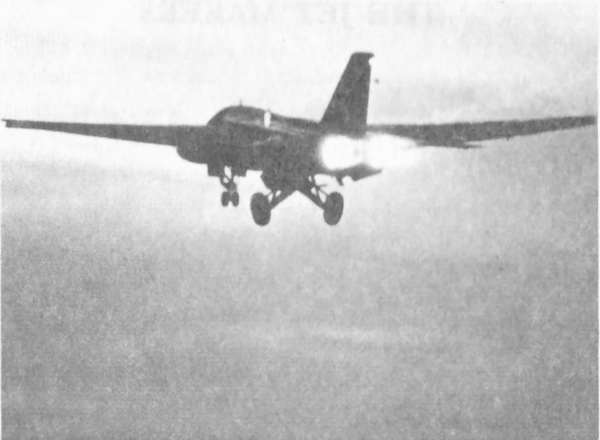 A stage in the design of the Boeing XB-47 with jet engines inside the body, side intakes, and exhausts over the wing section. This photo is of wind tunnel model FR65 (FR for Flight Research), design model 432. It was taken 17 July 1945. Courtesy The Boeing Company. The design history of the XB-52 heavy bomber is linked to that of the XB-47 because of the incorporation of development experience. It began in April 1945, when the AAF asked for a long-range,. turbine bomber design. The first Boeing configuration was ready for a June 1946 design competition. It won. This first model resembled the B-36, with six propjet engines, and it was expected to weigh 350,000 to 400,000 pounds. Range projections of this model were unsatisfactory, however. When Wright thought that they could produce a more powerful engine, the design was shrunk in late 1946 to a four-propjet version, but it still was short on range and speed. To get better performance, aerial refueling was accepted as necessary, and in early 1948 the wings were swept gently and contrarotating propellers were used. By the summer, propjet engine development for the XB-52 was in trouble, and prospects for the power plant to be ready in less than four years were dim. Wright Field proposed conversion to jet engines. Boeing's solution, resulting in part from the success of their B-47, was to use eight jet engines in four pods and to increase wing sweep; and the XB-52 evolved into a scaled-up B-47.
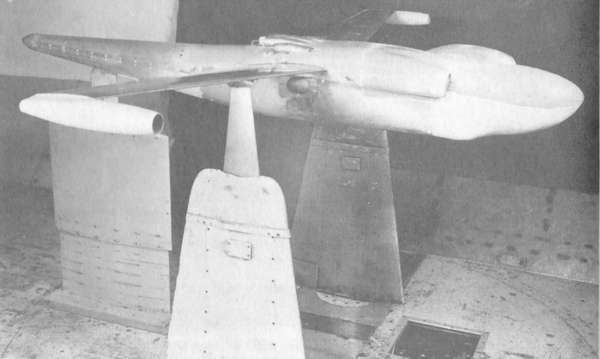 Another photo of wind tunnel model FR65 with jet engine installation under the wing tips. This picture was taken 22 August 1945. Courtesy The Boeing Company.
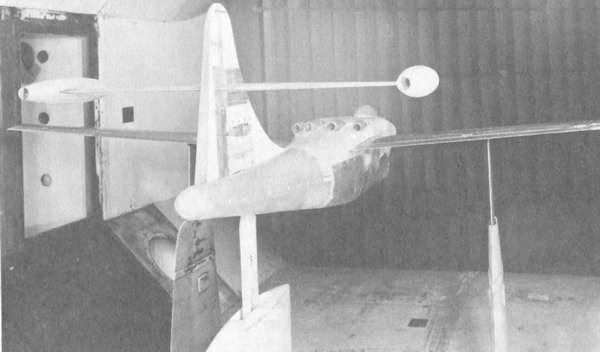 This picture was taken 22 August 1945. Courtesy The Boeing Company.
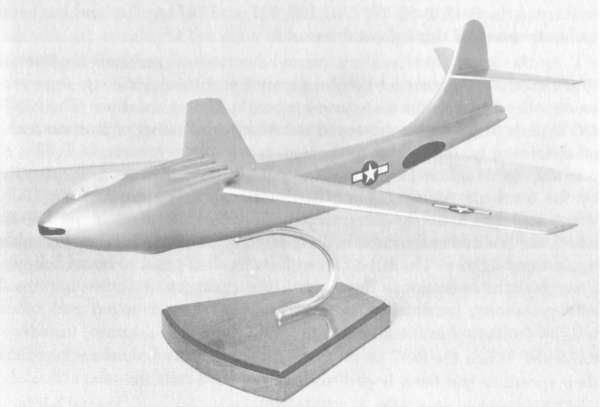 This picture was taken 15 September 1945. Courtesy The Boeing Company.
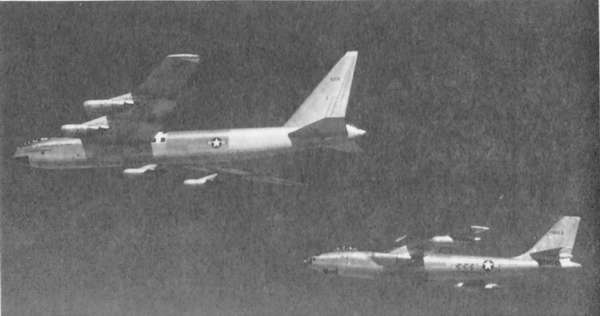 Two historic aircraft: the Boeing B-52 and B-47. Their swept airfoils and suspended engines are the hallmark of the modern large jet airplane. Contrast their lines with those of the B-45, which used traditional piston-era approaches in its straight wing and tail and engines integral with the wing. Courtesy The Boeing Company. Boeing's B-17 had established the form of the large four-engine piston airplane, and Boeing engineers had now spent eight intensive years on the design and development of big turbine aircraft. Almost every conceivable turbine engine combination and mounting had been tried, and every style of non delta wing had been examined. The design possibilities were manifold, but in the end Boeing knew they had found an effective combination for the big airframe. It has served them for a quarter of a century in the B-47, B-52, 707, 720, 727, 737, and 747 families and has been generally adopted throughout the world. As the Boeing jet bombers neared operational service, the Korean War demonstrated that jet bombers were not just an idealistic improvement: they had become necessary for bombardment aviation. The MiG15's superb performance destroyed the American illusion of Russian technical inferiority. Designed to destroy a possible successor to B-29's, it was able to slaughter the B-29. The Superfortress, still used in quantity by the Strategic Air Command, fled to the cover of darkness in 1951. What was even more shocking, the MiG's were masters of the jet RB-45, which the bomber enthusiasts had expected to be practically invulnerable against any fighter. The RB-45, as well as the B-29, had to be withdrawn from daylight operations. Faced with the prospect of future improved enemy fighters, fourteen of the B-36's guns were removed and other weight eliminated so it could operate at 50,000 feet and above, to redress the odds. When the B-47 jet bombers finally became operational in 1951 their speed, as had been hoped, was a problem to the fighters.
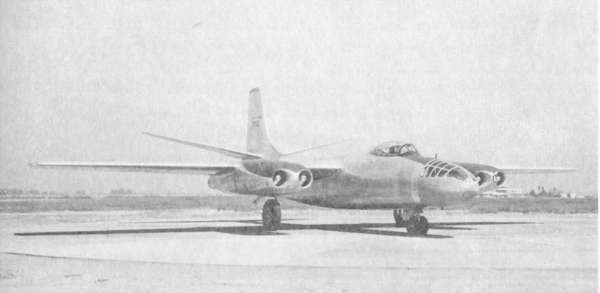 America's first jet bomber was the North American B-45. The Air Force believed its speed would make it nearly invulnerable to fighters. The MiG-15 quickly disabused the Air Force of this wishful thinking. Courtesy Rockwell International Corporation. The bomber was soon in difficulty again, however, as technology advanced. With jet-thrust augmentation, or afterburning, faster climb rates and supersonic level flight to over Mach 2 were attained. The missile, with conventional or nuclear warhead and terminal guidance, was developed for use by the fighter, and weapon aiming was made simpler by avionics. By the midfifties the fighter had once more attained a marked superiority over the bomber, and the development of excellent antiaircraft missiles at the same time compounded the bomber's problem. Vigorous efforts were made to restore the bomber's viability. The Strategic Air Command had long planned to use fighter escort systems, but the extreme range of Soviet targets made traditional escorts difficult even with aerial refueling. An attempt was made to adopt the B-36 into a flying aircraft carrier to solve this problem, while fighters were modified to be carried in the bomb bays or on the wing tips. Some fighters were to do the bombing, thus creating a stand-off bombing system for the B-36. The B-58 of 1957 and the XB-70 were developed to give the bomber supersonic speeds to limit the fighter's advantage, but the B-58 had only a supersonic dash, and that was at high altitudes. The XB- 70 had continuous supersonic flight, but the speed generated enough heat to make the bomber a dream target for missiles using heat-seeking guidance, and it was easy for radar to find. McNamara called it a strategic dinosaur. For years intensive efforts to provide the bomber with an air-to-air missile defense against fighters failed technologically.
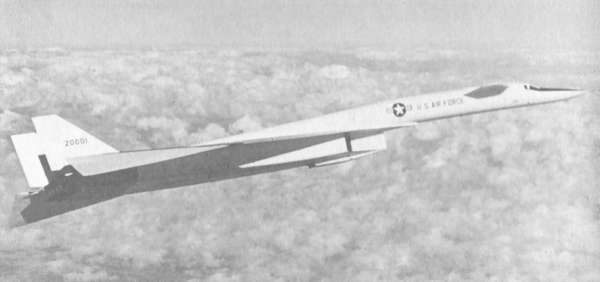 The North American XB-70 could be described in superlatives for most of its properties. Unfortunately, two disadvantages were cost and expected vulnerability to air defense weapons developed by the sixties. It was not a total loss, however, because of the technology learned in its design. Courtesy Rockwell International Corporation.
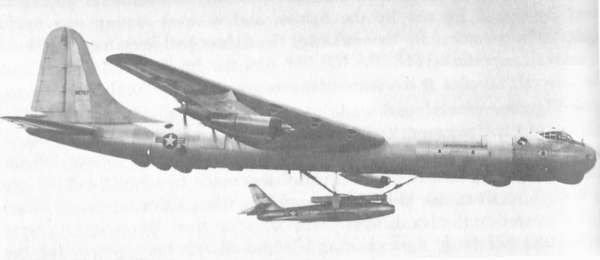 A Republic F-48F on its trapeze being retracted into the bomb bay of an RB-36F carrier aircraft. Courtesy General Dynamics Corporation. In the end the only practical courses of action were development of stand-off air-to-ground missiles, such as Hound Dog and Skybolt, to be used against surface air-defense installations as the bomber flew towards the target; use of electronic countermeasures (ECM); and flying just above the ground so as to hide from radar. New models, the 1959 B-52G and 1961 H, had to be developed for the low-altitude tactic. The heavy losses to be expected from grand-strategic operations against a competent enemy, with the highest loss estimates at a rate of 75 percent to 90 percent, reduced the bomber in the sixties to an auxiliary weapon. The bomber-oriented Air Force refused to accept this as a permanent condition, and renewed development proposals for heavy bombers followed each defeat of an earlier attempt, until the B-1 project was successfully implemented in 1970. The Air Force even, in desperation, sought to reopen assembly lines for the B-47, B-52, and B-58. A measure of the intensity of the desire for more manned bombers is shown by the B-58's inclusion in this list, for its production was ended early, in 1962, because of Air Force distaste for such a small bomber. The twilight of both heavy and medium bombers as well as the auxiliary tankers, which started in the late fifties, resulted in the loss of a major market to the aerospace industry. This was the first large sales loss to the industry as a whole, and it was of special importance to Boeing, which had dominated both strategic and tanker markets. Boeing was able to partially offset the steep decline in its sales to the government by having the foresight to take over the Air Force strategic-missile business with the Minuteman.
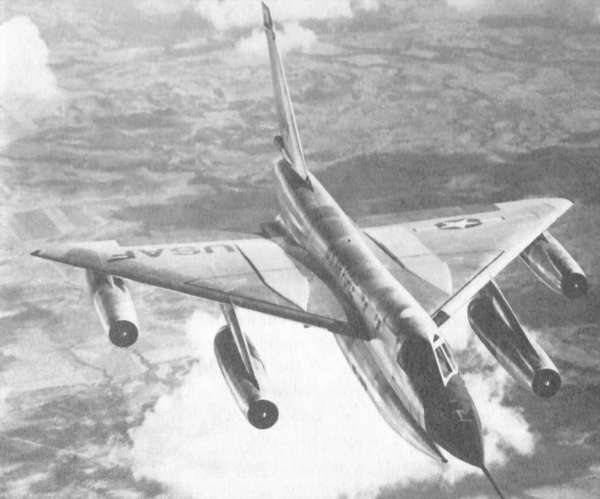 The beautiful General Dynamics B-58 high-performance bomber. Courtesy General Dynamics Corporation. General of the Air Force H. H. Arnold accurately predicted in 1945 that the missile would displace the grand-strategic bomber. His vision, together with a resolve that American aeronautical inferiority should not be repeated, led to the creation of two agencies to advise the AAF on directions to take in research and development (R&D). One was RAND (Research and Development Corporation), which soon proposed an earth-satellite project. The AAF did not follow this advice, but it did accept that of the other agency, the Scientific Advisory Group, led by Dr. Theodore von Karman. This second advisory group made proposals intended to establish a foundation for future development. One was to emulate the German organization for research and development, wherein all technical disciplines pertinent to a project had been brought together into a unit. Today this is called a "systems" approach. Other recommendations emphasized air supremacy in the near future and downgraded advanced missiles. It is ironic that, to avoid repetition of the earlier technological lag caused by short-term development, the group appointed to advise the Air Force was now recommending a similar shortterm approach. RAND, whose advice was initially rejected, did better. Nevertheless, some work did begin on intercontinental guided missiles although the emphasis was on two unmanned aircraft, successors to the German V-I: the Northrop Snark and the North American Navaho. The Snark was to be jet powered and subsonic, the Navaho to be ramjet powered and supersonic. There were years of struggle and failures with the Snark. The missile ultimately became operational only at squadron strength because it was vulnerable. The Mach 3 Navaho also went through years of difficulties and was successfully fired only after it had been canceled in 1957. Two other unmanned aircraft were developed, the Fairchild Goose, intended to divert air defenses from bombers, and the Boeing Bomarc interceptor. The Goose was canceled for the same reasons as the Snark and Navaho: too vulnerable. Bomarc alone became operational in significant, although small, numbers. Curiously, production was continued at this time on the big subsonic manned bombers, which were twenty times as expensive and not much less vulnerable-an inconsistency which can only be explained by a "battleship general" outlook: dogged clinging to a weapon for itself.
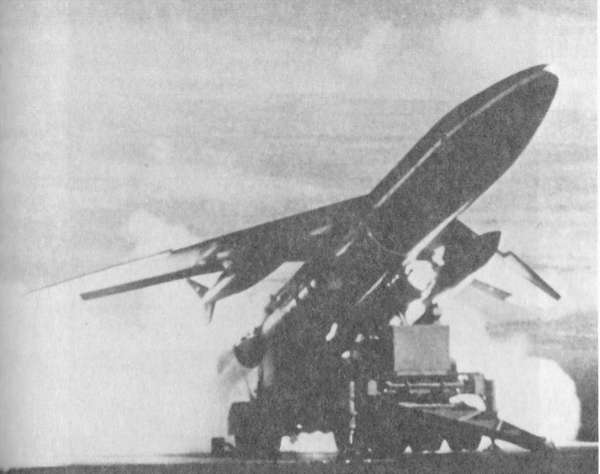 For a few years it was believed that the unmanned aircraft would bridge the operational gap between bomber and ballistic missile just as it did the technological. However, it proved to be vulnerable. Shown here is the launch of a Northrop Snark, which was put into service in small numbers. Courtesy Northrop Corporation. The unmanned aircraft, a guided missile, was for years believed to be easier to develop than the ballistic missile, and it was expected to be a bridge to the latter. As it turned out, the ballistic missile was less difficult to achieve than the unmanned intercontinental aircraft because the guidance was easier. But the technological relationships, the aero dynamics, were linked as if development were to progress from jet aircraft to unmanned aircraft, then to missile.
 The mighty General Dynamics Atlas ICBM at launch. Courtesy General Dynamics Corporation. Work on the ballistic missile began early. The V-2 and the atomic bomb inspired a contract between the AAF and Convair in April 1946 for Project MX-774, ancestor of the Atlas ICBM. The work did not enjoy a high priority because the expected accuracy, together with the yield and weight of the atomic weapon, appeared to render the missile impractical. In June 1947 MX-774 was canceled, yielding to more immediate SAC concerns during an economy drive. To put MX-774 into perspective as a program, about $465 million were spent for all research and development purposes in fiscal years 1946 through 1948, but only $2.25 million had been devoted to MX-774. In one of those fortunate cases of vision, Convair continued limited work on the ICBM with its own funds. When the dry hydrogen bomb was achieved in 1953, the yield-weight-accuracy combination changed to favor the ICBM. It assumed top priority in 1954 as knowledge of its feasibility and Russian development efforts combined to dictate urgency. To assure success, not only was General Dynamics' Atlas put in development but a competitor, the Martin Titan, was sponsored as well. As concern deepened over Russian progress, especially after Khrushchev "rattled his rockets" during the 1956 Suez crisis, it was realized that an IRBM could be made operational earlier because its shorter range meant simpler solutions. The Air Force produced its Thor in the late fifties in competition with the Army's Jupiter. Before these liquid-fueled missiles were successful, a solid fuel engine practical for big rockets was developed. Boeing realized this early and, concerned over future prospects for its bombers, worked hard in 1958 to win the Air Force solid-fuel ICBM competition.
 Launch of a Martin Marietta Titan ICBM. Courtesy Martin Marietta Corporation. Successful development of the ICBM and IRBM came during the crisis of the bombers, and the missiles assumed the main aerospace-nuclear strategic role. Cheaper than bombers, they were invulnerable after launch. They had relatively short production runs, but production did not end when the missile silos were fined, for improvements caned for replacements. In addition, the ICBM and IRBM were useful as boosters for the space program. PERSISTENCE: OTHER COMMANDSThe Tactical Air Command (TAC) was the Air Force's orphan combat command until conventional warfare was reemphasized under President Kennedy. Its initial existence was entirely the result of a suggestion by Eisenhower: the AAF organized TAC to ensure Ike's support in the autonomy struggle. Never very powerful in the early years, it expired before the Korean War. Limited war restored it, however, and tactical airpower specialists in the Air Force attempted to gain a stronger voice; but they did not get far, and an effort to simplify and lighten tactical aircraft failed. In the fifties TAC sought to support the new Eisenhower concept of limited war by organizing, together with Army elements, a highly mobile strike force caned the Composite Air Strike Force (CASF). Aerial refueling was to be the key to achieving a global force to head off or fight small wars. Supersonic fighters, nuclear weapons, and a greatly improved tactical transport-the propjet Lockheed C-130 Hercules-gave the concept promise, and the CASF performed adequately when needed. It was cheaper to operate than the Navy's equivalent force, the carriers; but because of the emphasis on strategic air, TAC operated with low priority for everything. For example, its tankers were cast-offs from SAC. In the late fifties the smaller missiles led some to believe that tactical aircraft were obsolete, except for the transports, and concern for the continued existence of T AC as late as 1959 led its commander, General F. F. Everest, to conceive of the F-111 (TFX). He hoped the F-111 could compete with missiles and also serve as a junior strategic bomber. How he could believe the latter function could be included without TAC's being organizationally swallowed by SAC is puzzling.Kennedy's conventional-warfare emphasis put TAC on an assured footing, although it has not become much larger. For the aerospace industry, TAC's story has meant that the jet fighter business has been good in war but poor in peace. Fighters have continued to be cyclical; no company has done wen with USAF fighters for the whole period, 1945 to 1972, and the one company that specialized in Air Force fighters, Republic, failed. Yet, unlike the bomber, the fighter still appears to have a future with the Air Force and for export. And the fighter, along with the transport, is one of the best possibilities for the long serial production that spells profits. Fairchild had good business with the C-119 for tactical airlift, but that business was lost to the C-130. Then Lockheed had a large market in supplying transports for our Air Force and for exports. The 1949 piston C-119 never had the usefulness and reliability of the 1954 propjet C-130, a design which was still in production two decades later. For over a quarter of a century the workhorse jet engine created a continuing market for its services in tactical airpower. The air-defense market, on the other hand, proved temporary. Before there was a discernible Russian air threat the Air Defense Command (ADC) was formed. Lacking resources of consequence it was virtually a phantom command, resting primarily upon the concept of big-bomber primacy, which in turn bestowed some status on the counterweapon. Emergence of a Russian air-nuclear capability in the early fifties, followed by the USAF miscalculation that the Soviet Air Force was building a massive grand-strategic bombing force, caused a mushrooming growth of ADC in the midfifties. Growth stopped with successful development of the ICBM, and with the eventual realization in the late fifties that Russia was emphasizing grand-strategic missiles and not bombers, as had been believed. It appears the American miscalculation and redirection was a mixture of being hoodwinked by the Russians, the self-deception of top Air Force generals in imputing their own intentions to others, and a change in plans as technology solved the feasibility problems of the ICBM. The Russians did build a small force of 840 jet bombers, and together with nuclear weapons it remains a threat to the continental United States. Although the mechanics of air-defense demand almost as great a force to combat a small bomber fleet as a large one, it has been possible to reduce the U.S. interceptor force from its peak. The stable nature of the Soviet bomber force means that the existing interceptor force will continue to be serviceable. Thus, although the interceptor market rose rapidly in the fifties, it has been almost nonexistent since. The emergence of the ICBM as the main threat has not provided a market for an antiballistic missile (ABM), however. The technological problems of the ABM have not been simplified, its costs have been appalling, and the hypothesis has been generally accepted that defenselessness will preserve the balance of terror and, therefore, peace. The third command, the Military Airlift Command (MAC), has, like the Tactical Air Command, grown in recognition. MAC performs strategic -that is, international or global-airlift functions, hauling large payloads for long distances in short times. As with commercial air transport, the power-to-weight efficiency of the jet engine has made strategic airlift increasingly effective and important. Repeated attempts to achieve that goal with piston engines met with moderate success. Of the giants that were built in this effort at the end of World War II, the Douglas C-74 Globemaster I, Lockheed R60 Constitution, and Convair XC-99, derived from the B-36, were unsuccessful. The Douglas C-I24 Globemaster II of 1949, informally called "The Aluminum Cloud" and "The Flying Reynolds-Wrap," and the semigiant Boeing C-97 Stratofreighter of the end of World War II were the best of the large piston transports. Propjet efforts were made with the canceled Douglas C-132 and the 1957 C-133 Cargomaster. Progress towards jets and modern aircraft was not as fast as the Military Air Command wanted and technology permitted. The command had no jet transport until ten years after jet bombers were in service, and in 1963 the piston transport was still the backbone of the fleet. One of the rationalizations put forth by the bomber generals, a claim which sounds strange coming from the Air Force, was that speed was unimportant in a transport. This idea -was not shared by those in the transport business: the airlines and the airlift command.
The C-133 was followed by a major step: the C-130 Hercules concept was enlarged
and equipped with jet engines, and the result was a greatly improved strategic
transport: the 1964 Lockheed C-141 StarLifter. Its success encouraged belief
that the ultimate size could be achieved. The Lockheed C-5A Galaxy, also called
"The Aluminum Overcast" or "Fat Albert," was built next; and the apparent
commercial success of the C-5A's airliner counterparts-the Boeing 747, Lockheed
L-I011 TriStar, and McDonnell DC-IO-indicates that the jet engine has made the
giant air transport, and therefore large-scale strategic airlift, feasible.
General Arnold, in 1945, not only prophesied the ICBM, he also forecast an air
capability to deliver ground forces, completely equipped, at any point in the
world within hours. Such strategic airlift should have as bright a future as its
commercial counterpart, and be an additional continuing market for the aerospace
industry.
|